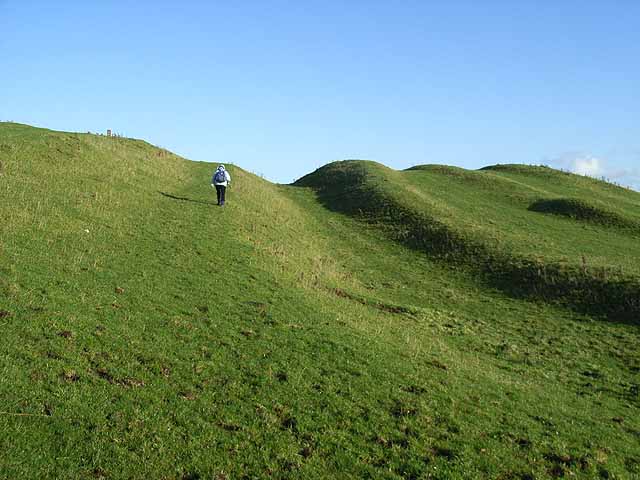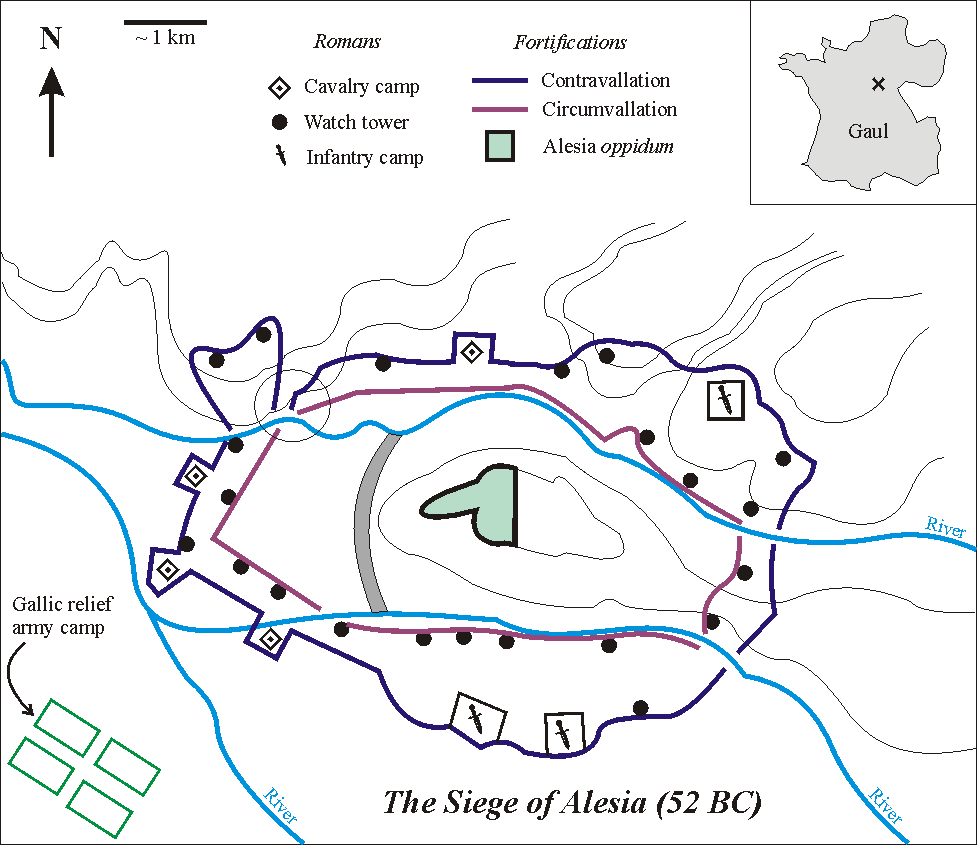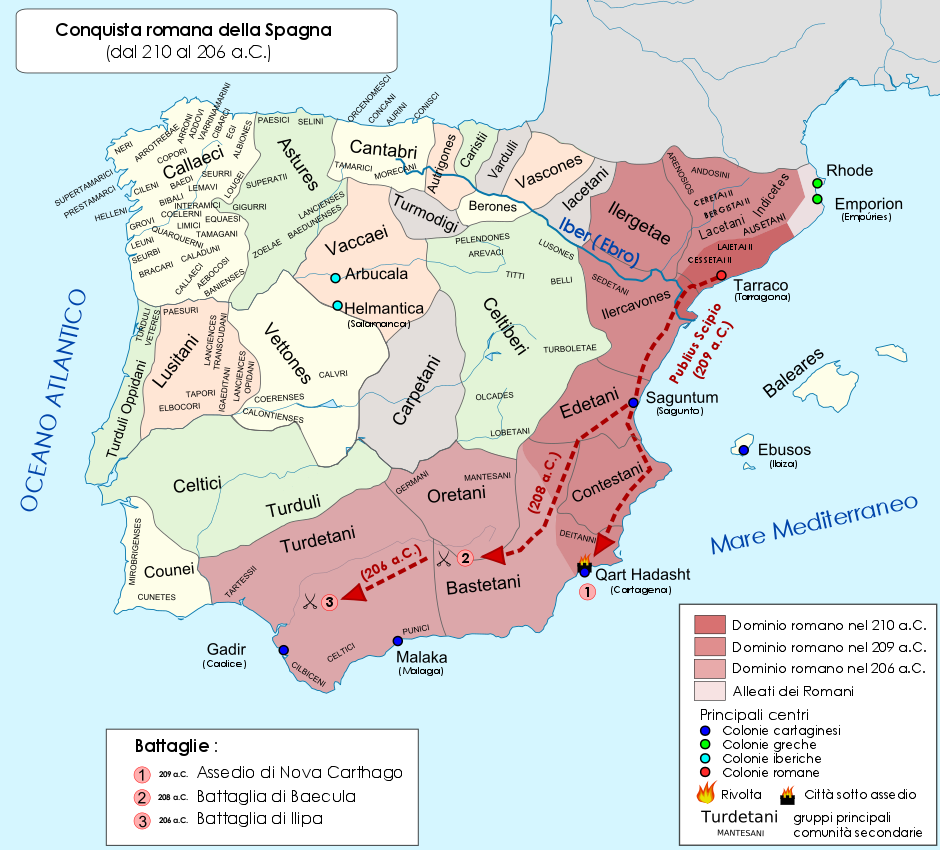|
Vallum
Vallum is either the whole or a portion of the fortifications of a Roman camp. The vallum usually comprised an earthen or turf rampart ( Agger) with a wooden palisade on top, with a deep outer ditch (fossa). The name is derived from '' vallus'' (a stake), and properly means the palisade which ran along the outer edge of the top of the agger, but is usually used to refer to the whole fortification. Characteristics The stake-like valli (χάρακες) of which the vallum palisade was composed are described by Polybius (xviii.18.1, Excerpt. Antiq. xvii.14) and Livy (Liv. xxxiii.5), who make a comparison between the vallum of the Greeks and that of the Romans, very much to the advantage of the latter. Both used for valli young trees or arms of larger trees, with the side branches on them; but the valli of the Greeks were much larger and had more branches than those of the Romans, which had either two or three, or at the most four branches, and these generally on the same side. The Gr ... [...More Info...] [...Related Items...] OR: [Wikipedia] [Google] [Baidu] |
Vallum (Hadrian's Wall)
The Vallum is a huge earthwork associated with Hadrian's Wall in England. Unique on any Roman frontier, it runs practically from coast to coast to the south of the wall. It was built a few years after the wall. Current opinion is that the Vallum demarcated the southern boundary of a military zone, bounded on the north by the wall. The earliest surviving mention of the earthwork is by Bede who refers to a ''vallum'', or earthen rampart, as distinct from the wall, or ''murus''; the term is still used despite the fact that the essential element is a ditch, or ''fossa''. Layout and course The Vallum comprises a ditch that is nominally wide and deep, with a flat bottom, flanked by two mounds about 6 metres wide and high, set back some from the ditch edges. For a great deal of its length a third lower mound, the so-called marginal mound, occupies the south berm (flat area between mound and ditch), right on the southern lip of the ditch.Heywood, B. (1966). "The Vallum—Its ... [...More Info...] [...Related Items...] OR: [Wikipedia] [Google] [Baidu] |
Sudis (stake)
The ''sudis'' (: ''sudes'') was a stake carried by Roman legionaries for employment as a field fortification, sometimes also called ''vallus''. It is frequently, but incorrectly, called a ''pilum murale'' (). Typically, two such stakes were carried by each soldier. Construction Each stake was made of hardwood, usually oak, about long and about wide at the thickest point. Square in section, the shape tapers to a point at both ends. The central part is narrowed in a way that strongly suggests the function of a handle, although this may not be its actual purpose. Examples that have been found are rough hewn. Usage It seems clear that the stakes were used to form a temporary defence. However, the exact manner in which stakes were used is the subject of debate among experts. It is possible that the stakes were incorporated into the ramparts of a Roman marching camp (''castra ''Castra'' () is a Latin language, Latin term used during the Roman Republic and Roman Empire for ... [...More Info...] [...Related Items...] OR: [Wikipedia] [Google] [Baidu] |
Peloponnesian League
The Peloponnesian League () was an alliance of ancient Greek city-states, dominated by Sparta and centred on the Peloponnese, which lasted from c. 550 to 366 BC. It is known mainly for being one of the two rivals in the Peloponnesian War (431–404 BC), against the Delian League, which was dominated by Athens. Name The Peloponnesian League is the modern name given to the Spartan system of alliances, but it is inaccurate because there were members outside the Peloponnese, and it was not really a league. The ancient name of the League was "the Lacedemonians and their allies". This is misleading as well, because Sparta could have allies outside of the Peloponnesian League. History Foundation (c. 550 BC) In its early history, Sparta expanded by conquering Laconia and Messenia and reducing their population into slavery (as helots), but the subjugation of Tegea on its northern border failed at the battle of the Fetters. Following this defeat, Sparta abandoned its military ... [...More Info...] [...Related Items...] OR: [Wikipedia] [Google] [Baidu] |
Goths
The Goths were a Germanic people who played a major role in the fall of the Western Roman Empire and the emergence of medieval Europe. They were first reported by Graeco-Roman authors in the 3rd century AD, living north of the Danube in what is now Ukraine, Moldova, and Romania. From here they conducted raids into Roman territory, and large numbers of them joined the Roman military. These early Goths lived in the regions where archaeologists find the Chernyakhov culture, which flourished throughout this region during the 3rd and 4th centuries. In the late 4th century, the lands of the Goths in present-day Ukraine were overwhelmed by a significant westward movement of Alans and Huns from the east. Large numbers of Goths subsequently concentrated upon the Roman border at the Lower Danube, seeking refuge inside the Roman Empire. After they entered the Empire, violence broke out, and Goth-led forces inflicted a devastating defeat upon the Romans at the Battle of Adrianople in 378. Ro ... [...More Info...] [...Related Items...] OR: [Wikipedia] [Google] [Baidu] |
Byzantine Greeks
The Byzantine Greeks were the Medieval Greek, Greek-speaking Eastern Romans throughout Late Antiquity and the Middle Ages. They were the main inhabitants of the lands of the Byzantine Empire (Eastern Roman Empire), of Constantinople and Asia Minor (modern Turkey), the Greek islands, Cyprus, and portions of the southern Balkans, and formed large minorities, or pluralities, in the coastal urban centres of the Levant and northern Egypt. Throughout their history, they self-identified as ''Ῥωμαῖοι, Romans'' (). Latin speakers identified them simply as Greeks or with the term Romaei. Use of Koine Greek, Greek was already widespread in the eastern Roman Empire when Constantine I () moved its capital to Constantinople, while Anatolia had also been Hellenization, hellenized by early Byzantine times. The empire lost its diversity following the loss of non-Greek speaking provinces with the 7th century Early Muslim conquests, Muslim conquests and its population was overwhelmingly ... [...More Info...] [...Related Items...] OR: [Wikipedia] [Google] [Baidu] |
Julius Caesar
Gaius Julius Caesar (12 or 13 July 100 BC – 15 March 44 BC) was a Roman general and statesman. A member of the First Triumvirate, Caesar led the Roman armies in the Gallic Wars before defeating his political rival Pompey in Caesar's civil war, a civil war. He subsequently became Roman dictator, dictator from 49 BC until Assassination of Julius Caesar, his assassination in 44 BC. Caesar played a critical role in Crisis of the Roman Republic, the events that led to the demise of the Roman Republic and the rise of the Roman Empire. In 60 BC, Caesar, Marcus Licinius Crassus, Crassus, and Pompey formed the First Triumvirate, an informal political alliance that dominated Roman politics for several years. Their attempts to amass political power were opposed by many in the Roman Senate, Senate, among them Cato the Younger with the private support of Cicero. Caesar rose to become one of the most powerful politicians in the Roman Republic through a string of military victories in the G ... [...More Info...] [...Related Items...] OR: [Wikipedia] [Google] [Baidu] |
Battle Of Alesia
The Battle of Alesia or siege of Alesia (September 52 BC) was the climactic military engagement of the Gallic Wars, fought around the Gauls, Gallic ''oppidum'' (fortified settlement) of Alesia (city), Alesia in modern France, a major centre of the Mandubii tribe. It was fought by the Roman army of Julius Caesar against a confederation of List of peoples of Gaul, Gallic tribes united under the leadership of Vercingetorix of the Arverni. It was the last major engagement between Gauls and Romans, and is considered one of Caesar's greatest military achievements and a classic example of siege warfare and Investment (military), investment; the Roman army built dual lines of fortifications—an inner wall to keep the besieged Gauls in, and an outer wall to keep the Gallic relief force out. The Battle of Alesia marked the end of Gallic independence in the modern day territory of France and Belgium. The battle site was probably atop Mont Auxois, above modern Alise-Sainte-Reine in Fran ... [...More Info...] [...Related Items...] OR: [Wikipedia] [Google] [Baidu] |
Numantia
Numantia () is an ancient Celtiberian settlement, whose remains are located on a hill known as Cerro de la Muela in the current municipality of Garray ( Soria), Spain. Numantia is famous for its role in the Celtiberian Wars. In 153 BC, Numantia experienced its first serious conflict with Rome. After twenty years of hostilities, in 133 BC the Roman Senate gave Scipio Aemilianus Africanus the task of destroying Numantia. History Numantia was an Iron Age hill fort (in Roman terminology an ''oppidum''), which controlled a crossing of the river Duero. Pliny the Elder counts it as a city of the Pellendones, but other authors, like Strabo and Ptolemy place it among the Arevaci people. The Arevaci were a Celtiberian tribe, formed by the mingling of Iberians and migrating Celts in the 6th century BC, who inhabited an area near Numantia and Uxama. The first serious conflict with Rome occurred in 153 BC when Quintus Fulvius Nobilior was consul. Numantia took in some fugiti ... [...More Info...] [...Related Items...] OR: [Wikipedia] [Google] [Baidu] |
Appian
Appian of Alexandria (; ; ; ) was a Greek historian with Roman citizenship who prospered during the reigns of the Roman Emperors Trajan, Hadrian, and Antoninus Pius. He was born c. 95 in Alexandria. After holding the senior offices in the province of Aegyptus (Egypt), he went to Rome c. 120, where he practiced as an advocate, pleading cases before the emperors (probably as ''advocatus fisci'', an important official of the imperial treasury). It was in 147 at the earliest that he was appointed to the office of procurator, probably in Egypt, on the recommendation of his friend Marcus Cornelius Fronto, an influential rhetorician and advocate. Because the position of procurator was open only to members of the equestrian order (the "knightly" class), his possession of this office tells us about Appian's family background. His principal surviving work (Ρωμαϊκά ''Romaiká'', known in Latin as ''Historia Romana'' and in English as ''Roman History'') was written in Greek i ... [...More Info...] [...Related Items...] OR: [Wikipedia] [Google] [Baidu] |
Scipio Africanus
Publius Cornelius Scipio Africanus (, , ; 236/235–) was a Roman general and statesman who was one of the main architects of Rome's victory against Ancient Carthage, Carthage in the Second Punic War. Often regarded as one of the greatest military commanders and strategists of all time, his greatest military achievement was the defeat of Hannibal at the Battle of Zama in 202 BC. This victory in Africa earned him the honorific epithet ''Africanus'', literally meaning 'the African', but meant to be understood as a conqueror of Africa (Roman province), Africa. Scipio's conquest of Carthaginian Iberia culminated in the Battle of Ilipa in 206 BC against Hannibal's brother Mago Barca. Although considered a hero by the Roman people, primarily for his victories against Carthage, Scipio had many opponents, especially Cato the Elder, who hated him deeply. In 187 BC, he was tried in a show trial alongside his brother for bribes they supposedly received from the Seleucid king Antiochus III ... [...More Info...] [...Related Items...] OR: [Wikipedia] [Google] [Baidu] |
Carthage
Carthage was an ancient city in Northern Africa, on the eastern side of the Lake of Tunis in what is now Tunisia. Carthage was one of the most important trading hubs of the Ancient Mediterranean and one of the most affluent cities of the classical world. It became the capital city of the civilization of Ancient Carthage and later Roman Carthage. The city developed from a Phoenician colony into the capital of a Punic people, Punic empire which dominated large parts of the Southwest Mediterranean during the first millennium BC. The legendary Queen Elissa, Alyssa or Dido, originally from Tyre, Lebanon, Tyre, is regarded as the founder of the city, though her historicity has been questioned. In the myth, Dido asked for land from a local tribe, which told her that she could get as much land as an oxhide could cover. She cut the oxhide into strips and laid out the perimeter of the new city. As Carthage prospered at home, the polity sent colonists abroad as well as magistrates to rule t ... [...More Info...] [...Related Items...] OR: [Wikipedia] [Google] [Baidu] |
Ditch (fortification)
In military engineering, a ditch is an obstacle designed to slow down or break up an attacking force, while a Trench warfare, trench is intended to provide cover to the defenders. In military fortifications, the side of a ditch furthest from the enemy and closest to the next line of defence is known as the scarp (fortification), scarp while the side of a ditch closest to the enemy is known as the counterscarp. Uses In early fortifications, ditches were often used in combination with rampart (fortification), ramparts to slow down the enemy whilst defensive fire could be brought to bear from the relative protection afforded by the rampart and possibly the palisade. In medieval fortifications, a ditch was often constructed in front of a defensive wall to hinder Mining (military), mining and escalade activities from an attacker. When filled with water, such a defensive ditch is called a moat. However, moats may also be dry. Star forts designed by military engineers like Vauban, co ... [...More Info...] [...Related Items...] OR: [Wikipedia] [Google] [Baidu] |







